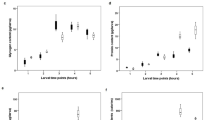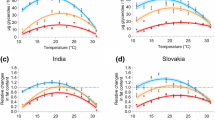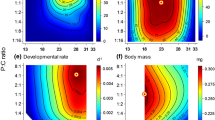Abstract
Drosophila simulans is more abundant under colder and drier montane habitats in the western Himalayas as compared to its sibling D. melanogaster but the mechanistic bases of such climatic adaptations are largely unknown. Previous studies have described D. simulans as a desiccation sensitive species which is inconsistent with its occurrence in temperate regions. We tested the hypothesis whether developmental plasticity of cuticular traits confers adaptive changes in water balance-related traits in the sibling species D. simulans and D. melanogaster. Our results are interesting in several respects. First, D. simulans grown at 15 °C possesses a high level of desiccation resistance in larvae (~39 h) and in adults (~86 h) whereas the corresponding values are quite low at 25 °C (larvae ~7 h; adults ~13 h). Interestingly, cuticular lipid mass was threefold higher in D. simulans grown at 15 °C as compared with 25 °C while there was no change in cuticular lipid mass in D. melanogaster. Second, developmental plasticity of body melanisation was evident in both species. Drosophila simulans showed higher melanisation at 15 °C as compared with D. melanogaster while the reverse trend was observed at 25 °C. Third, changes in water balance-related traits (bulk water, hemolymph and dehydration tolerance) showed superiority of D. simulans at 15 °C but of D. melanogaster at 25 °C growth temperature. Rate of carbohydrate utilization under desiccation stress did not differ at 15 °C in both the species. Fourth, effects of developmental plasticity on cuticular traits correspond with changes in the cuticular water loss i.e. water loss rates were higher at 25 °C as compared with 15 °C. Thus, D. simulans grown under cooler temperature was more desiccation tolerant than D. melanogaster. Finally, desiccation acclimation capacity of larvae and adults is higher for D. simulans reared at 15 °C but quite low at 25 °C. Thus, D. simulans and D. melanogaster have evolved different strategies of water conservation consistent with their adaptations to dry and wet habitats in the western Himalayas. Our results suggest that D. simulans from lowland localities seems vulnerable due to limited acclimation potential in the context of global climatic change in the western Himalayas. Finally, this is the first report on higher desiccation resistance of D. simulans due to developmental plasticity of both the cuticular traits (body melanisation and epicuticular lipid mass) when grown at 15 °C, which is consistent with its abundance in temperate regions.





Similar content being viewed by others
Abbreviations
- D:
-
Desiccation resistant strains
- I. F.:
-
Isofemale
- J/mg:
-
Joules/mg
- RWL:
-
Rate of water loss
References
Arthur AL, Weeks AR, Sgrò CM (2008) Investigating latitudinal clines for life history and stress resistance traits in Drosophila simulans from eastern Australia. J Evol Bio 21:1470–1479
Ashburner M (1989) Drosophila: a laboratory handbook. Cold Spring Harbor Laboratory Press, New York
Bale JS (2002) Insects and low temperatures: from molecular biology to distributions and abundance. Phil Trans R Soc Lond B 357:849–862
Bazinet AL, Marshall KE, MacMillan HA, Williams CM, Sinclair BJ (2010) Rapid changes in desiccation resistance in Drosophila melanogaster are facilitated by changes in cuticular permeability. J Insect Physiol 56:2006–2012
Benoit JB, Yoder JA, Rellinger EJ, Ark JT, Keeney GD (2005) Prolonged maintenance of water balance by adult females of the American spider beetle, Mezium affine Boieldieu, in the absence of food and water resources. J Insect Physiol 51:565–573
Benoit JB, Lopez-Martinez G, Michaud MR, Elnitsky MA, Lee RE, Denlinger DL (2007) Mechanisms to reduce dehydration stress in larvae of the Antarctic midge, Belgica antarctica. J Insect Physiol 53:656–667
Benoit JB, Patrick KR, Desai K, Hardesty JJ, Krause TB, Denlinger DL (2010) Repeated bouts of dehydration deplete nutrient reserves and reduce egg production in the mosquito Culex pipiens. J Exp Biol 213:2673–2679
Bubliy OA, Kristensen TN, Kellermann V, Loeschcke V (2012) Plastic responses to four environmental stresses and cross-resistance in a laboratory population of Drosophila melanogaster. Funct Ecol 26:245–253
Chippindale AK, Gibbs AG, Sheik M, Yee KJ, Djawdan M, Bradley TJ, Rose MR (1998) Resource allocation and the evolution of desiccation resistance in laboratory selected Drosophila melanogaster. Evolution 52:1342–1352
Chown SL, Nicolson SW (2004) Insect physiological ecology: mechanisms and patterns. Oxford University Press, Oxford
Cohen AC, March RB, Pinto JD (1986) Effects of water stress and rehydration in hemolymph volume and amino acid content in the blister beetle Cysteodemus armatus. Comp Biochem Physiol A 85:743–746
Demerec M, Kaufman BP (1996) Drosophila guide: introduction to the genetics and cytology of Drosophila melanogaster, 10th edn. Carnegie Institute of Washington, USA
Djawdan M, Chippindale AK, Rose MR, Bradley TJ (1998) Metabolic reserves and evolved stress resistance in Drosophila melanogaster. Physiol Zool 71:584–594
Edney EB (1977) Water balance in land arthropods. Springer, Berlin
Eisses K Th, Santos M (1998) Species distinction in abdominal pigmentation patterns between females of Drosophila melanogaster and D. simulans, from a Spanish population. Entomol News 109:56–60
Elnitsky MA, Benoit JB, Denlinger DL, Lee RE (2008) Desiccation tolerance and drought acclimation in the Antarctic collembolan Cryptopygus antarcticus. J Insect Physiol 54:1432–1439
Folk DG, Bradley TJ (2005) Adaptive evolution in the lab: unique phenotypes in the fruit flies comprise a fertile field of study. Integ Comp Biol 45:492–499
Folk DG, Han C, Bradley TJ (2001) Water acquisition and partitioning in Drosophila melanogaster: effects of selection for desiccation resistance. J Exp Biol 204:3323–3331
Gibbs AG (1999) Laboratory selection for the comparative physiologist. J Exp Biol 202:2709–2718
Gibbs AG (2002) Water balance in desert Drosophila: lessons from non-charismatic microfauna. Comp Biochem Physiol A 133:781–789
Gibbs AG, Matzkin LM (2001) Evolution of water balance in the genus Drosophila. J Exp Biol 204:2331–2338
Gibbs AG, Chippindale AK, Rose MR (1997) Physiological mechanisms of evolved desiccation resistance in Drosophila melanogaster. J Exp Biol 200:1821–1832
Gibbs AG, Fukuzato F, Matzkin LM (2003) Evolution of water conservation mechanisms in desert Drosophila. J Exp Biol 206:1183–1192
Graves JL, Toolson EC, Jeong C, Vu LN, Rose MR (1992) Desiccation, flight, glycogen, and postponed senescence in Drosophila melanogaster. Physiol Zool 65:268–286
Hadley NF (1977) Epicuticular lipids of the desert tenebrionid beetle, Eleodes armatus : seasonal and acclimatory effects on chemical composition. Insect Biochem 7:227–283
Hadley NF (1989) Lipid water barriers in biological systems. Prog Lipid Res 28:1–33
Hadley NF (1994) Water relations of terrestrial arthropods. Academic Press, San Diego
Hadley NF, Quinlan MC (1989) Cuticular permeability of the black widow spider Latrodectus hesperus. J Comp Physiol B 159:243–248
Hadley NF, Schultz TD (1987) Water loss in three species of tiger beetles (Cicindela): correlations with epicuticular hydrocarbons. J Insect Physiol 33:677–682
Hoffmann AA (1990) Acclimation for desiccation resistance in Drosophila melano-gaster and the association between acclimation responses and genetic variation. J Insect Physiol 36:885–891
Hoffmann AA (1991) Acclimation for desiccation resistance in Drosophila: species and population comparisons. J Insect Physiol 37:757–762
Hoffmann AA (2010) Physiological climatic limits in Drosophila: patterns and predictions. J Exp Biol 213:870–880
Hoffmann AA, Harshman LG (1999) Desiccation and starvation resistance in Drosophila: patterns of variation at the species, population and intrapopulation levels. Heredity 83:637–643
Hoffmann AA, Parsons PA (1991) Evolutionary genetics and environmental stress. Oxford University Press, Oxford
Hoffmann AA, Parsons PA (1993a) Direct and correlated responses to selection for desiccation resistance: a comparison of Drosophila melanogaster and D. simulans. J Evol Biol 6:643–657
Hoffmann AA, Parsons PA (1993b) Selection for adult desiccation resistance in Drosophila melanogaster: fitness components, larval resistance, and stress correlations. Biol J Linn Soc 48:43–54
Hoffmann AA, Watson M (1993) Geographical variation in the acclimation responses of Drosophila to temperature extremes. Am Nat 142:93–113
Hoffmann AA, Hallas R, Sinclair C, Mitrovski P (2001) Levels of variation in stress resistance in Drosophila among strains, local populations, and geographic regions: patterns for desiccation, starvation, cold resistance, and associated traits. Evolution 55:1621–1630
Hoffmann AA, Sorensen JG, Loeschcke V (2003) Adaptation of Drosophila to temperature extremes: bringing together quantitative and molecular approaches. J Thermal Biol 28:175–216
Holmstrup M, Sømme L (1998) Dehydration and cold hardiness in the Arctic Collembolan Onychiurus arcticus (Tullberg, 1876). J Comp Physiol B 168:197–203
Holmstrup M, Hedlund K, Boriss H (2002) Drought acclimation and lipid composition in Folsomia candida: implications for cold shock, heat shock and acute desiccation stress. J Insect Physiol 48:961–970
Indian Meteorological Department (2010) Climatological tables of observatories in India. Controller of Publications, Government Press, New Delhi
Kellermann V, Van Heerwaarden B, Sgrò CM, Hoffmann AA (2009) Fundamental evolutionary limits in ecological traits drive Drosophila species distributions. Science 325:1244–1246
Loveridge JP, Bursell E (1975) Studies on the water relations of adult locusts (Orthoptera: Acrididae). 1. Respiration and the production of metabolic water. Bull Entomol Res 65:13–20
Marron MT, Markow TA, Kain KJ, Gibbs AG (2003) Effects of starvation and desiccation on energy metabolism in desert and mesic Drosophila. J Insect Physiol 49:261–270
Matzkin LM, Mutsaka K, Johnson S, Markow TA (2009) Metabolic pool differences among ecologically diverse Drosophila species. J Insect Physiol 55:1145–1150
Nicolson SW (1980) Water balance and osmoregulation in Onymacrisplana, a tenebrionid beetle from the Namib Desert. J Insect Physiol 26:315–320
Parkash R, Kalra B, Sharma V (2008) Changes in cuticular lipids, water loss and desiccation resistance in a tropical drosophilid: analysis of within population variation. Fly 2:189–197
Parkash R, Kalra B, Sharma V (2010) Impact of body melanisation on contrasting levels of desiccation resistance in a circumtropical and a generalist Drosophila species. Evol Ecol 24:207–225
Parsons PA (1975) The comparative evolutionary biology of the sibling species, Drosophila melanogaster and D. simulans. Q Rev Biol 50:151–169
Parsons PA (1983) The evolutionary biology of colonizing species. Cambridge University Press, New York
Parsons PA, Stanley SM (1981) Domesticated and widespread species. In: Ashburner M, Carson HL, Thompson JN Jr (eds) The genetics and biology of Drosophila, vol 3a. Academic Press, London, pp 349–393
Powell JR (1997) Progress and prospects in evolutionary biology: the Drosophila model. Oxford University Press, New York
Rajpurohit S, Parkash R, Ramniwas S (2008) Body melanisation and its adaptive role in thermoregulation and tolerance against desiccating conditions in drosophilids. Entomol Res 38:49–60
Rourke BC (2000) Geographical and altitudinal variation in water balance and metabolic rate in a California Grasshopper, Melanoplus sanguinipes. J Exp Biol 203:2699–2712
Schmidt-Nielsen K (1990) Animal physiology: adaptation and environment, 4th edn. Cambridge University Press, New York
Telonis-Scott M, Guthridge KM, Hoffmann AA (2006) A new set of laboratory selected Drosophila melanogaster lines for the analysis of desiccation resistance: response to selection, physiology and correlated responses. J Exp Biol 209:1837–1847
Toolson EC (1984) Interindivididual variations in epicuticular hydrocarbon composition and water loss rates of the cicada, Tibicen dealbatus (Homoptera: Cicadidae). Physiol Zool 57:5505–5556
Toolson EC, Hadley NF (1979) Seasonal effects on cuticular permeability and epicuticular lipid composition in Centruroides sculpturatus Ewing 1928 (Scorpiones: Buthidae). J Comp Physiol 129:319–325
Tsacas L (1980) Family Drosophilidae. In: Crosskey RW (ed) Catalogue of the Diptera of the Afrotropical Region. British Museum (Natural History), London, pp 673–685
Wharton GW (1985) Water balance of insects. In: Kerkut GA, Gilbert LI (eds) Comprehensive insect physiology, biochemistry and pharmacology, vol 4. Pergamon Press, Oxford, pp 565–603
Willmer P, Stone G, Johnston I (2000) Environmental physiology of animals. Blackwell Science, Oxford
Zar JH (1999) Biostatistical analysis, 4th edn. Prentice-Hall, London
Acknowledgments
We are indebted to three anonymous reviewers for several helpful comments which improved the MS. Financial assistance from Council of Scientific and Industrial Research, New Delhi [Emeritus Scientist project no. 21(0847)11 EMR-11] is gratefully acknowledged. Divya Singh, Chanderkala Lambhod and Poonam Ranga are thankful to University grants commission, New Delhi, for award of Rajiv Gandhi National Fellowship (RGNF).
Author information
Authors and Affiliations
Corresponding author
Additional information
Communicated by G. Heldmaier.
Rights and permissions
About this article
Cite this article
Parkash, R., Aggarwal, D.D., Singh, D. et al. Divergence of water balance mechanisms in two sibling species (Drosophila simulans and D. melanogaster): effects of growth temperatures. J Comp Physiol B 183, 359–378 (2013). https://doi.org/10.1007/s00360-012-0714-3
Received:
Revised:
Accepted:
Published:
Issue Date:
DOI: https://doi.org/10.1007/s00360-012-0714-3




